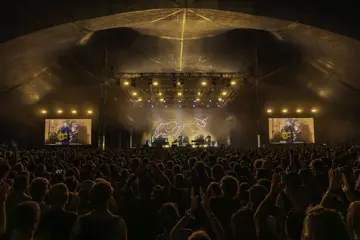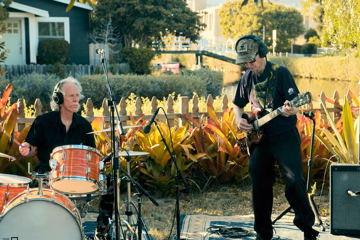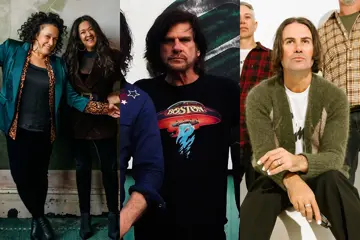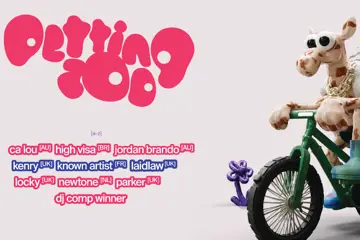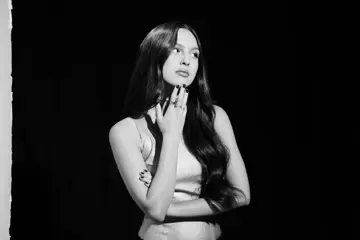The 2025 Regional & Remote Music Summit is in full force in Byron Bay’s Community Centre this week. Taking the resources to the underdogs, the three-day conference has banded together industry leaders in touring, marketing, media, and more to highlight strategies for underlooked remote and regional artists and audiences.
The second conference day featured an ambitious and expansive update from Music Australia and Creative Australia, who, through their innovative research and generous pockets, delivered a clear message: regional Australia is not a footnote, but a cornerstone of the industry.
In a tightly-packed session, Creative Australia’s Dr Christen Cornell and subsidiary company Music Australia’s Director Millie Millgate walked attendees through recent research, new funding mechanisms, and long-term strategies designed to support musicians, audiences, and cultural infrastructure outside the major metros.
The presentation spanned audience trends, climate risk, touring support, and the growing digital toolkit available to regional creatives, and was done so in a way that valued numbers and metrics over blanket suggestions.
The Listening In Report: “Scarcity and Desire”
Don't miss a beat with our FREE daily newsletter
Dr Christen Cornell – a research fellow & the manager of research partnerships at Creative Australia – began by unpacking her research from the past few years. The Listening In series – a qualitative three-pronged report on Australian music audiences, launched across April to June 2025.
The research delved into live attendance, discoverability, and consumption, using a nationally representative sample via data company Nielsen and partnerships with the likes of The Daily Aus, Untitled Group and The Push.
The findings revealed four key themes in Australian audiences. It was found that, despite international music’s chokehold on streaming and broadcasting, 71% of respondents felt a strong national pride for Australian music. There was also a clear belief in live music as a support for mental wellbeing, with 93% saying it “positively addresses mental health.”
But the research also highlighted a persistent divide.
“Compared with audiences living in metro areas,” Cornell explained, “those located in regional or remote (areas) were significantly more likely to report ‘a lack of nearby events that I want to attend’ as a barrier.
However, they were also much more likely to agree with the statement that ‘I would attend more local Australian music if it was available near me.’”
Cornell added,“perhaps there’s a relationship there between scarcity and desire.”
The Bass Line: Valuing the Industry
Launched earlier this year, The Bass Line is Creative Australia’s ongoing economic impact study, measuring the music industry’s direct contribution to the Australian economy.
Round one of the study revealed an eye-watering $2.82 billion in Gross Value Added (GVA), with over 1,000 stakeholders contributing data – from artists and venues, to labels and agents.
“(This) was actually a tremendous exercise in building some of that resurgent infrastructure,” Cornell said.
While still in its infancy, Cornell is urging industry figures to stay in the loop with the study for its emerging second phase: “We’re going to be doing this annually.
"We’re about to put that out again in September for the second round. So please, if you see that in your socials, if you see that come across your path, please participate. And of course, we want to get – we need to get – a really strong set of data from regional and remote."
The project marks a pivot toward data-backed advocacy, providing industry with solid economic proof points when negotiating policy or funding. “The better (the data) we get,” Cornell stressed, “the more that we can kind of slice that to say things about the situation of regional and remote communities at stake.”
Climate Risk and Festivals: A Forecast of Urgency
A third research project, currently awaiting publishing but eagerly previewed at 2025’s Summit, is Climate Resilience and Australian Festivals – a collaboration with academics from RMIT and La Trobe.
While the study focuses on the broader community and cultural festivals, its implications for music events are significant.
“It's looking at climate disruption – climate disruptions to festivals.” Cornell explained.
“We would really like to upscale this project into something that is more focused on music festivals, that looks not only at how we might better prepare festivals for climate disruptions and kind of work with a more networked or collaborative approach, but that might also look at the way that festivals can build climate resilience, particularly in regional communities.”
Disproportionate climate events are evidently on the rise in festival-land, from the ‘Splendour in the Mud’ fiasco of post-covid 2022 (very close to home for the Summit’s Byron community), to heatwaves and fire danger singeing 2024’s Pitch Music and Arts Festival in Moyston. And, despite the mammoth task of shifting the heat from the climate to the line-ups, reputation recovery can be difficult.
The findings aim to equip organisers not just to react to climate events, but to lead on climate-conscious planning, from navigating changing audience behaviours, increasing costs and strained resources (such as with police or medic staffing), and current strategies for adaptation. As for a publishing date, Cornell says by August or September is the ballpark.
Music Australia’s Market Development: Dollars & Delivery
Director Millie Millgate shifted the focus mid-set from data to delivery, laying out Music Australia’s market development approach — including a $12.5 million investment in regional and remote activity across Creative Australia in 2025.
“When we refer to market development,” Millgate began, “it’s really the notion of building national and international profiles through developing relationships, networks and market opportunities.
According to Millgate, Music Australia’s avenues of focus include “grassroots, like music venues; regional and remote; music festivals; music export; What's happening with screen opportunities; and new technologies.”
The Contemporary Music Touring Program (CMTP), came to the forefront of this development, offering tiered grants from $15,000 to a whopping $50,000, depending on the number of regional stops.
While CMTP incentivises traditionally metro-minded musos to explore regional & remote options, Millgate also acknowledged Music Australia’s introduced commitment to travel bursaries for regional and remote hometown heroes. This year, the Creative Australia body used such bursaries to fly 36 attendees from across the country to Byron Bay for the summit, the recipients clapping proudly in the audience.
“It doesn’t work if we don’t have representation,” she said. “It doesn’t work if there aren’t people here from every state and territory.”
With state and territory governments co-funding the program, Millgate confirmed that Music Australia's plan is “to absolutely keep going with (the initiatives), because it’s just so important to have you here and have your voices heard. And, more importantly,” Millgate stresses, “for you to meet each other.”
Millgate also hinted at a new regional initiative launching in August and closing mid-October. Details are scarce, but she confirmed it’s “a direct result from attending this conference last year,” adding with a grin, “I tried [to say more], but I can’t.”
Now You Can Too: Accessible Tools For Touring
While the interlinked government bodies are spearheading the research that will activate adaptation in the years to come, both Millgate and Cornell discussed new tools that provide accessible geographical data that puts the hyper-local knowledge in any touring manager or muso’s pocket.
Extending the research front to the people, Creative Australia’s Electorate Profiles tool was pitched as a game-changer for regional advocacy. Accessible via the Creative Australia website, the tool offers real-time stats by federal electorate, including ticket sales, participation, employment, venue capacity, and more.
“You can kind of run down the left-hand side, find your federal electorate, click on it. Then what you'll get is a collection of data from various data sets, including the ABS and TEG Ticketing data,” Cornell explained.
There are future ambitions to break it down further — by Local Government Authorities or even First Nations geographies — but for now, it’s a pretty nifty tool for artists and organisations seeking the kind of knowledge that only a local could know.
Meanwhile, the announcement of MusicNSW’s Regional Touring Network (RTN) going nation-wide also delivers an adjacent interactive geographic mapping tool. The digital map helps artists plan regional tours with detailed venue profiles covering tech specs, accessibility, accommodation, and local knowledge.
As MusicNSW staffer Helen Henry put it, “It’s just so exciting that this is going to be rolling out across the country.”
A New Chapter for AMIN — and a Hint at RRMS 2026
In a nod to local-grown collaboration, Millgate formally introduced Emily Tulloch as the newly appointed Project Manager for the Australian Music Industry Network (AMIN) – a role designed to strengthen cooperation between state and territory music bodies.
Tulloch, who was announced in her new role by The Music earlier in the month, will be based at MusicSA and tasked with weaving the AMIN network into a more unified national support system – especially for those working in and from the regions.
To give more information that would permeate with listeners long after the segment, Millgate teased that another Regional & Remote Music Summit announcement is likely in August or September. “It’s important these aren’t one-and-done,” she said. “This is an ongoing commitment — and we’re already thinking about number three.”
The Remote and Regional Music Summit for 2025 will continue in Byron Bay until Friday, before wrapping its second year.
This piece of content has been assisted by the Australian Government through Music Australia and Creative Australia, its arts funding and advisory body



